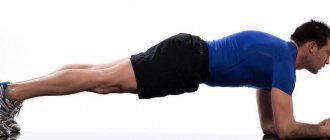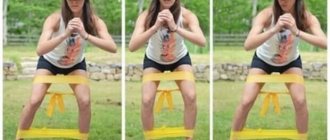One of the popular and effective simulators for home and professional use is the orbitrek. It is also called an elliptical trainer, since the legs move along the trajectory of an ellipse during exercise. The arms are also involved: they move synchronously with the legs, which improves the effect of training. Most of all, exercises on the orbit track imitate the movements of a person on skis, and this sport is considered one of the most beneficial for health.
Benefits of an elliptical trainer
The elliptical trainer has many benefits for the health and beauty of your body. The main ones:
- weight loss (you can burn up to 400 kcal* in one workout);
- improved balance and coordination;
- training the whole body in a safe environment for joints and ligaments;
- strengthening the respiratory and cardiovascular systems;
- acceleration of metabolism.
* The number of calories burned is individual, the average value is indicated. Calorie loss depends on your weight, age, fitness, medical conditions and much more.
Contraindications to training with orbitrek
Each simulator has a number of contraindications for training. We do not recommend using an elliptical trainer for athletes with:
- hypertension;
- tachycardia;
- attacks of cardiac asthma;
- heart failure;
- thrombophlebitis;
- angina pectoris;
- oncology;
- diabetes mellitus;
- acute infection;
- swelling.
Before training, either with an elliptical or with any other sports equipment, we advise you to consult a doctor. This way you will not harm your own health and will be confident in the positive results of the exercises.
First aid
If you get injured on the simulator, it is important to perform only the correct and thoughtful actions, otherwise you can cause more harm.
First of all, you should stop exercising on the elliptical and call a doctor or an ambulance. First aid consists of the following manipulations:
- It is contraindicated to abruptly move the victim, change his position, sit him down and give him something to drink, as well as independently adjust joints in case of dislocation and sprain. Only doctors can accurately determine the severity of the injury and its nature. The victim must be kept at rest.
- A cold compress is applied to the injured area. An ice bag, a cold towel, or even a bag of frozen food will do. Cooling will reduce swelling, reduce bruising, and reduce inflammation and pain. To prevent frostbite, the compress should be alternated with breaks and applied for 10-30 minutes every 20-30 minutes.
- Measure the pressure. In hypertension and heart disease, blood pressure plays an important role. If it is too high, the risk of heart attack and stroke increases. Even before the ambulance arrives, you can give the victim medicine. However, it is important to help him take only what is prescribed and prescribed. It is strictly contraindicated to offer drugs that the person has not taken before.
- If a dislocation is suspected, a tight bandage is immediately applied to the damaged area and the position of the limb is fixed until doctors arrive.
- If internal bleeding is suspected, the victim must be helped to take a comfortable position.
- In case of miscarriage, a semi-sitting position will be preferable. The bleeding will decrease slightly.
- For abdominal injuries, it is advisable to elevate your legs.
- For traumatic brain injuries, carefully place something under the head.
- While waiting for an ambulance, it is important to monitor the victim's breathing. If necessary, perform cardiopulmonary resuscitation.
Advantages of an elliptical trainer over a treadmill
Recently, training with elliptical trainers has become very popular. In many ways they can be superior to running on a treadmill. Let's look at the Top 5 reasons why ellipses win over tracks.
- By training on an elliptical, you significantly reduce the load on the spine, knee and ankle joints. This significantly reduces the risk of injury. And the pedals, located a short distance from each other, minimize hip rotation and reduce pressure on the lower back.
- With an elliptical trainer, you can train multiple muscle groups at the same time. Since most models are equipped with special handrails that involve the muscles of the shoulder girdle.
- With the ellipse, you can move both forward and backward. This significantly changes the nature of the load, and the training becomes more varied and effective.
- Classes with modern ellipsoid models are available to athletes of large dimensions. Since the maximum possible weight of a student can be 120-150 kg.
- While training with the orbitrek, you can simultaneously watch YouTube, listen to music or learn a foreign language. After all, the exercises do not require special concentration and are quite safe, unlike the treadmill.
Ellipsoid for weight loss
The main question that interests those losing weight when choosing an elliptical trainer is: does it help you lose weight? Of course, like any cardio machine, the elliptical is effective for weight loss. Firstly, training on the orbit track provides additional calorie consumption. Secondly, regular exercise does not contribute to a faster breakdown of fats in the body.
Nutrition during training on the elliptical
But first, it’s worth emphasizing once again that the process of losing weight occurs when you consume fewer calories than you burn. Without dietary restrictions, losing weight will be difficult even with regular exercise. If you are not yet ready to radically change your menu, you can simply follow the general advice that underlies the principles of proper nutrition.
General nutrition tips:
- Eliminate industrial sweets, sugar, fast food, and flour products from your menu.
- Give preference to boiled and baked foods
- Drink 1.5-2 liters of water a day, this dulls the feeling of hunger
- Include more fresh vegetables and fruits in your menu (you should not overuse bananas and grapes as fruits)
- Try to eat small meals 5-6 times a day
- Don't forget about breakfast and don't skip dinner (about 3 hours before bedtime)
- Consume enough protein in food: meat, fish, cottage cheese, legumes, eggs (about 2 g of protein per 1 kg of weight)
- Fast carbohydrates are best consumed in the morning
Muscle work during training on an elliptical
The big advantage of the ellipsoid compared to other exercise machines is that it works the muscles of the upper and lower body simultaneously. For example, during exercise on a treadmill and exercise bike, the muscles of the legs and buttocks are mainly worked. Orbitrek also gives a load to both the leg muscles and the arm muscles. And the more muscles are activated during training, the more calories are burned. In addition, this makes the load on the body more uniform and of higher quality.
What muscles work during training on the elliptical:
- Anterior thigh muscles (quadriceps)
- Muscles of the back of the thigh (biceps femoris)
- Gluteal muscles
- Deltoids (shoulders)
- Biceps and triceps (arms)
- Latissimus dorsi and trapezius
- Psoas muscles
- Rectus abdominis muscle
Please note that muscles do not grow from training on an elliptical trainer. They will tone up a little, the relief will appear due to a decrease in the fat layer, but there will be no increase in muscle mass from exercising on a cardio machine. This is simply impossible. If you want to build muscle and increase mass, then you need to do strength training with heavy weights.
By the way, the elliptical trainer uses the abdominal muscles to a lesser extent, so you can work on them additionally. For example, you could add a 10-minute core session after your cardio workout. Check out our selection: Top 50 exercises for abdominal muscles.
Is the elliptical trainer effective for weight loss?
Let's look again at the effectiveness of the elliptical trainer for weight loss. It is important to note that you cannot lose weight from exercise alone! An integrated approach is required: training + nutrition. Moreover, 80% of success depends on nutrition. However, training is an important component. Regular fitness helps tone your muscles (this makes your body firm and toned) and helps you burn extra calories (which means you will lose weight faster, all other things being equal).
In an hour of training on the elliptical, you can burn 400-800 kcal, depending on the intensity of the exercise and your level of physical fitness. The more advanced you are, the fewer calories you will burn per session. Therefore, do not forget to increase the load as your endurance and muscle strength increase.
10 tips for training on the elliptical:
- Always exercise on the elliptical in sports shoes (preferably running sneakers) and comfortable sportswear made from natural materials. Don't forget to ventilate the room before training.
- You can exercise on an elliptical trainer at any time of the day; this does not affect its effectiveness. Choose a time that is convenient and comfortable for you.
- Before training, be sure to do warm-up exercises for the whole body, and after training, stretching to avoid clogged muscles and soreness.
- Drink a glass of water 15 minutes before your workout and a glass of water 5 minutes after you finish your workout. During your workout on the elliptical, be sure to drink water: one or two sips every 5-10 minutes of exercise.
- Do not eat at least 1.5 hours before training (a light snack can be 45 minutes before). If you work out in the morning on an empty stomach, training on the elliptical trainer should not last more than 40 minutes.
- Within half an hour after training, have a small meal that consists of protein and carbohydrates. For example, cottage cheese + apple, chicken breast + vegetables or protein shake.
- To achieve effective results, training must be regular. Don't expect rapid weight loss after 2-3 weeks of exercise. The first noticeable results can be seen after 2-3 months (this applies to any training, not just on the ellipse).
- If you consume more calories per day than your body can burn, then you will not lose weight even with daily intense training (or you will, but very slowly). Nutrition control is a must if you want to burn fat!
- We recommend combining elliptical training with regular strength training. This will help tighten your body and speed up the fat burning process. It is better to exercise on an elliptical after strength training or distribute it over different days.
- If you want to put extra stress on your legs or just make your elliptical workout more challenging, you can wear leg weights or a resistance band.
Ellipse training plan
You can create a workout plan on the elliptical trainer yourself or consult a fitness trainer. We offer several principles for training on the ellipse that you can follow.
How long to train on an elliptical for weight loss:
- For beginners: 3 times a week for 20 minutes
- For intermediate level of training: 4 times a week for 30-40 minutes
- For advanced training: 4-5 times a week for 45-60 minutes
How long to train on the elliptical to stay in shape:
- For beginners: 2 times a week for 20 minutes
- For intermediate level of training: 2-3 times a week for 30 minutes
- For advanced training: 3 times a week for 45 minutes
What should your heart rate be while exercising on an elliptical trainer? Beginners can train at an average heart rate (heart rate) of 110-120 beats. To calculate your heart rate, use the built-in sensors, which are usually located on the handles of the ellipsoid. If you want to get more accurate values, it is better to purchase a fitness bracelet or heart rate monitor. You can also measure your pulse manually using a stopwatch, but this is not always convenient.
How to calculate the optimal heart rate zone? To do this, use the formula: Maximum heart rate = 220 minus your age. For an effective workout, you need to train in the zone of 70-80% of your maximum heart rate. For example, your age is 35 years old. This means that maximum heart rate = 220 – 35 = 185 beats per minute. Accordingly, an effective cardio workout for fat burning will take place at a heart rate of 130-148 beats per minute (0.7*185 and 0.8*185).
Read more in the article on cardio training.
Interval training plan on the elliptical (for burning fat):
- First 10 minutes: easy walking at an increasing pace for 10 minutes (heart rate in the 50-60% zone)
- Main part: alternating low-intensity intervals for 4-5 minutes (heart rate in the 60% zone) and high-intensity intervals for 1-2 minutes (heart rate in the 80% zone)
- Last 5 minutes: Slow walking to restore heart rate
Moderate training plan on the elliptical (to develop endurance):
- First 10 minutes: easy walking at an increasing pace for 10 minutes (heart rate in the 40-50% zone)
- Main part: fast walking in the heart rate zone of 50-60%
- Last 5 minutes: Slow walking to restore heart rate
If you want to turn off the use of your hands while practicing on the orbit track, you can hold on to the static handles without moving them. In this case, the muscles of the legs and buttocks will receive a stronger load.











